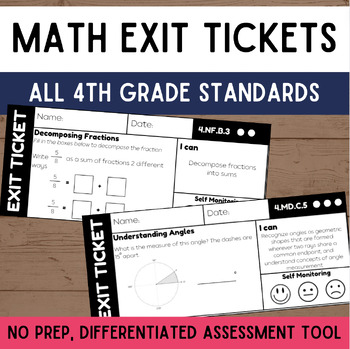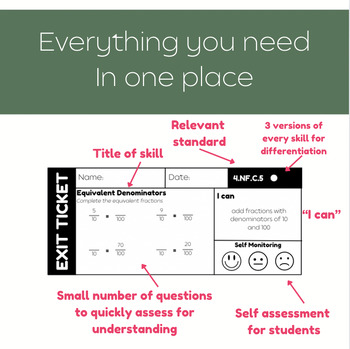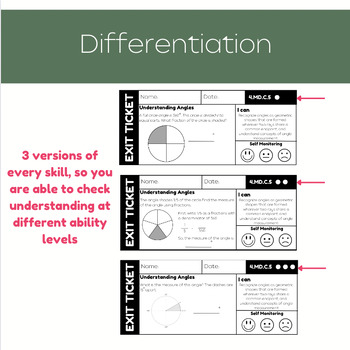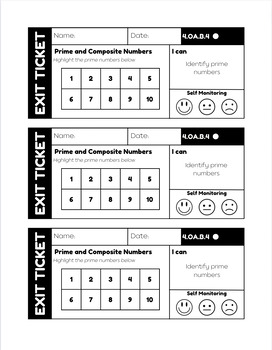Math Exit Tickets ~ 4th Grade Math assessment ~ Quick and Simple skill checker
Teaching in the blue
42 Followers
Grade Levels
3rd - 5th
Subjects
Resource Type
Standards
CCSS4.MD.A.1
CCSS4.MD.A.2
CCSS4.MD.A.3
CCSS4.MD.B.4
CCSS4.MD.C.5
Formats Included
- PDF
Pages
102 pages
Teaching in the blue
42 Followers
Description
4th Grade Exit Tickets
Math Exit Tickets are an essential resource designed to facilitate quick, targeted assessment of Grade 4 Common Core Math standards.
Features:
- Comprehensive Coverage: Encompassing all Common Core Math standards for Grade 4, Math Exit Tickets ensure that every essential skill is assessed thoroughly.
- Differentiated Assessment: Recognizing the diverse learning needs within a classroom, Math Exit Tickets provide differentiated questions to gauge understanding at varying levels of complexity. This allows educators to effectively evaluate the progress of every student, regardless of their individual learning pace.
- Quick Assessment: With a focus on efficiency, Math Exit Tickets offer a swift means of assessment, ideal for daily or periodic evaluations. Each exit ticket is designed to be completed in a short amount of time, making it easy to seamlessly integrate into daily lessons
- Versatile Application: Whether used as formative assessments to inform instruction, summative assessments to measure overall proficiency, or diagnostic assessments to identify areas for targeted intervention, Math Exit Tickets offer versatility in their application within the classroom
Common Core Standards Included:
- 4.OA.A.1 - Multiplication Comparison
- 4.OA.A.2 - Multiplication word Problems
- 4.OA.A.3 - Multi step word problems
- 4.OA.B.4 - Find factor pairs for whole numbers
- 4.OA.B.4 - Multiples of factors
- 4.OA.B.4 - Identify prime numbers
- 4.OA.C.5 - Shape Patterns
- 4.NBT.A.1 - Multi-digit place value
- 4.NBT.A.2 - Read and write multi digit whole numbers
- 4.NBT.A.2 - Comparing Multi-digit numbers
- 4.NBT.A.3 - Place Value Rounding
- 4.NBT.B.4 - Add and subtract multi-digit whole numbers
- 4.NBT.B.5 - Multiplication by 1 digit
- 4.NBT.B.5 - Multiplication by 2 digits
- 4.NBT.B.6 - Quotients and Remainders
- 4.NF.A.1 - Equivalent Fractions
- 4.NF.A.2 - Comparing Fractions
- 4.NF.B.3 - Adding and Subtracting Fractions
- 4.NF.B.3 - Decomposing Fractions
- 4.NF.B.3 - Add and subtract mixed numbers
- 4.NF.B.4 - multiply a fraction by a whole number
- 4.NF.C.5 - add fractions with denominators of 10 and 100
- 4.NF.C.6 - Use decimal notation for fractions
- 4.NF.C.7 - Compare two decimals
- 4.MD.A.1 - Know relative sizes of measurement units
- 4.MD.A.2 - Measurement Word Problems
- 4.MD.A.3 - Area and Perimeter
- 4.MD.B.4 - Line Plots
- 4.MD.C.5 - Understanding Angles
- 4.MD.C.6 - Measure angles with a protractor
- 4.MD.C.7 - Recognize angle measure as additive
- 4.GA.1 - Draw points, lines, line segments, rays, angles
- 4.GA.2 - Classify two-dimensional figures
- 4.GA.3 - Recognize a line of symmetry
Follow my store for more Math resources today!
Total Pages
102 pages
Answer Key
N/A
Teaching Duration
N/A
Report this resource to TPT
Reported resources will be reviewed by our team. Report this resource to let us know if this resource violates TPT’s content guidelines.
Standards
to see state-specific standards (only available in the US).
CCSS4.MD.A.1
Know relative sizes of measurement units within one system of units including km, m, cm; kg, g; lb, oz.; l, ml; hr, min, sec. Within a single system of measurement, express measurements in a larger unit in terms of a smaller unit. Record measurement equivalents in a two-column table. For example, know that 1 ft is 12 times as long as 1 in. Express the length of a 4 ft snake as 48 in. Generate a conversion table for feet and inches listing the number pairs (1, 12), (2, 24), (3, 36),...
CCSS4.MD.A.2
Use the four operations to solve word problems involving distances, intervals of time, liquid volumes, masses of objects, and money, including problems involving simple fractions or decimals, and problems that require expressing measurements given in a larger unit in terms of a smaller unit. Represent measurement quantities using diagrams such as number line diagrams that feature a measurement scale.
CCSS4.MD.A.3
Apply the area and perimeter formulas for rectangles in real world and mathematical problems. For example, find the width of a rectangular room given the area of the flooring and the length, by viewing the area formula as a multiplication equation with an unknown factor.
CCSS4.MD.B.4
Make a line plot to display a data set of measurements in fractions of a unit (1/2, 1/4, 1/8). Solve problems involving addition and subtraction of fractions by using information presented in line plots. For example, from a line plot find and interpret the difference in length between the longest and shortest specimens in an insect collection.
CCSS4.MD.C.5
Recognize angles as geometric shapes that are formed wherever two rays share a common endpoint, and understand concepts of angle measurement:





